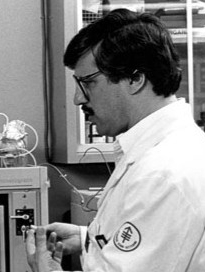Expansion of activated T-lymphocytes in patients treated with recombinant interleukin 2 Journal Article
| Authors: | Kolitz, J. E.; Welte, K.; Wong, G. Y.; Holloway, K.; Merluzzi, V. J.; Engert, A.; Bradley, E. C.; Konrad, M.; Polivka, A.; Gabrilove, J. L.; Sykora, K. W.; Miller, G. A.; Fiedler, W.; Krown, S.; Oettgen, H. F.; Mertelsmann, R. |
| Article Title: | Expansion of activated T-lymphocytes in patients treated with recombinant interleukin 2 |
| Abstract: | Recombinant interleukin 2 (rIL 2, Cetus) was administered in escalating doses to 30 patients with advanced malignancy, including 14 patients with the epidemic form of Kaposi’s sarcoma, in 2 week treatment cycles as a 6 h i.v. infusion for 10 doses. The maximum tolerated dose was 2 × 106 U/m2, with dose-limiting toxicity consisting of fever, diarrhea, and thrombocytopenia. At a well-tolerated dose of 1 × 106 U/m2, serum levels of rIL 2 of 30 U/ml were maintained for the duration of the infusion. Such concentrations sustain IL 2-dependent T cell growth in vitro. We observed a significant lymphocytosis in patients receiving 1 × 106 U/m2 of rIL 2 following 2 weeks of treatment (p = 0.0035). The expanded T cell pool was polyclonal, as demonstrated by increases in both T4 + and T8 + T cell subsets, and activated, with statistically significant increases in IL 2 receptor (p = 0.043), in the absence of transferrin receptor induction. Proliferating cells were not detected in peripheral blood using flow cytometry. Except for α-interferon, no other lymphokines (β- and γ-interferon, tumor necrosis factor) were present in serum during treatment. Reversible rises in anti-rIL 2 IgG antibodies occurred, as measured using an enzyme-linked immunosorbent assay. No changes were observed in the T cell mitogenic response to OKT3 and phytohemagglutinin, and no enhancement of cytotoxicity against natural killer-sensitive and resistant targets developed as a consequence of treatment. Except for a partial response in a patient with a myelodysplastic syndrome, no antitumor activity was observed. The in vivo expansion of T cells with the capacity to respond to rIL 2 with enhanced in vitro cytotoxicity against tumor targets provides impetus to ongoing trials exploring different routes and schedules of administration of rIL 2. © 1987 Raven Press, Ltd., New York. |
| Keywords: | adult; clinical article; aged; middle aged; advanced cancer; neoplasms; t lymphocyte; t-lymphocytes; interleukin 2; cancer immunotherapy; cell growth; cytotoxicity; recombinant proteins; killer cells, natural; metabolic clearance rate; kaposi sarcoma; leukocyte count; therapy; immunoglobulin g antibody; intravenous drug administration; interleukin-2; recombinant interleukin 2; antigens, surface; leukocytes; humans; human; male; female; killer cells; igg antibodies; blood and hemopoietic system; kaposi’s sarcoma; t cell growth; tumor targets |
| Journal Title: | Journal of Biological Response Modifiers |
| Volume: | 6 |
| Issue: | 4 |
| ISSN: | 0732-6580 |
| Publisher: | Lippincott-Raven |
| Date Published: | 1987-08-01 |
| Start Page: | 412 |
| End Page: | 429 |
| Language: | English |
| PUBMED: | 3498011 |
| PROVIDER: | scopus |
| DOI/URL: | |
| Notes: | Article -- Export Date: 5 February 2021 -- Source: Scopus |
Citation Impact
Related MSK Work









